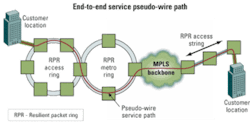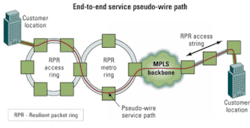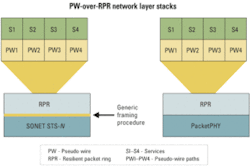RPR, pseudo wires boost service-provider networks
“Native” circuit services such as circuit voice and fax constitute an ever-dwindling percentage of service-provider (SP) network traffic. Since essentially all other key SP services come in the form of native packet or cell traffic, the growing demand for these services is driving SP network evolution.
Transport in traditional SP networks is based on SONET/SDH technology. These networks are optimized to carry constant-bandwidth circuit services and thus support bursty packet services quite inefficiently due to their inflexible multiplexing. To address such limitations, IEEE 802.17 resilient packet ring (RPR) was developed. In contrast to SONET/SDH, RPR is a resilient transport technology optimized for carrying packet services.
RPR can be used to upgrade existing SONET/SDH networks or for greenfield deployments. It provides an ideal mechanism for SPs to profitably deliver a range of services, including new high-bandwidth high-value services such as Ethernet transport. When paired with pseudo-wire (PW) technology, SPs can extend the benefits of RPR across multiple rings and even heterogeneous networks.
RPR is a Layer 2 protocol specified in IEEE 802.17-2004. It is optimized to carry traffic in SP networks based on ring topologies. Rings support simple efficient link-level protection and diverse fiber-path routing. RPR is designed to multiplex packet-based services over SP trunks and is not intended as an end-customer service port. This distinction is important. Key features of RPR are:
• Ring bandwidth shared by all stations on a ring. All traffic classes are statistically multiplexed within this shared bandwidth.
• Three quality of service (QoS) classes supported with per-class bandwidth guarantees. The highest priority, Class A, carries provisioned non-oversubscribed traffic. Class B supports both provisioned non-oversubscribed and oversubscribed traffic. Class C is best-effort traffic using what is not used by Class A and Class B. Higher-priority classes have strict-priority guarantees over lower classes.
• Ring-level “fair” access of all stations to oversubscribed bandwidth. That prevents bandwidth starvation or “unfairness” to any station on the ring.
• Bandwidth reclamation by “opportunistic” lower-priority service classes. If higher service classes are not using all of their allocated bandwidth, the bandwidth can be used by lower-priority classes.
• Ring-level protection with sub-50-msec recovery.
• Physical layer (PHY)-agnostic. Can be run over various PHYs, including SONET/SDH and PacketPHY, which is a Gigabit Ethernet (GbE)-like PHY running at 1 or 10 Gbits/sec.
• Up to 255 stations per ring, and a ring circumference of at least 2,000 km.
• Automatic plug and play topology and station-attribute discovery. Adding a station to a ring does not disrupt existing provisioned services.
• Significant operations, administration, and maintenance (OAM) support.
Class A is ideal for supporting services with extremely low latency requirements, such as circuit voice. Class B is well suited to bursty services with low-latency requirements, such as voice over IP (VoIP) and interactive video. Class C is ideally suited to general-purpose Web traffic, email, and other non-real time applications.
End-to-end delivery of a service may require transport across numerous interconnected RPR rings or even extend across heterogeneous networks with RPR and other Layer 2/3 technologies. RPR is concerned with individual rings; an end-to-end service-path mechanism (analogous to a SONET/SDH virtual tributary) can be used on top of RPR to support service delivery across a complex network.Pseudo wires can be used to deliver these end-to-end paths across complex packet-based transport networks (see Figure 1). A PW is an end-to-end service tunnel based on packet technology. PWs are currently being standardized in the IETF Pseudo Wire Emulation Edge to Edge (PWE3) Working Group. MPLS has emerged as the preferred SP PW technology due to its suitability for traffic engineering, scalability, cost-effective QoS architecture, flexibility, and inter-SP peering capabilities. PWs can be used to carry all network services, including circuit services, that can be carried by mapping circuit frames into packets.
PWs provide an ideal complement to RPR. Networks with MPLS PWs over RPR preserve RPR’s unique advantages of QoS with bandwidth efficiency, ring-level fair oversubscription, and sub-50-msec protection. To that, PWs add the following features:
• End-to-end connectivity. A PW provides connectivity across numerous RPR rings or other Layer 2 domains.
• Traffic engineering. PWs allow the traffic on each link and switching/multiplexing point to be “inventoried” by class. A network management system (NMS) can use this information to ensure the network has adequate resources to meet the required service-level agreement (SLA) of each service.
• Service management. A PW provides a mechanism for path-level OAM, including performance monitoring, statistics, alarms, and fault isolation.
By applying appropriate ingress traffic classification, rate limiting/policing, and traffic engineering via the NMS, a converged transport network based on PW over RPR can support all services with appropriate SLAs, including Ethernet, circuit, Frame Relay (FR), ATM, and backhaul from IP and ATM DSL access multiplexers (DSLAMs) carrying the full range of voice, video, and data traffic.
SONET/SDH is a Layer 1 (PHY) technology. In “standard” SONET/SDH transport, each service is mapped into its own path based on a TDM circuit, with that path having a fixed bandwidth that cannot be accessed by other services. These circuit paths are hierarchically multiplexed into SONET/SDH trunks. SONET/SDH service paths are optimized for the service characteristics and requirements of circuit voice: constant bandwidth traffic requiring “high” QoS with low latency and effectively zero traffic loss.
Most packet-service traffic is bursty, and many important services (e.g., general-purpose Web and virtual private network [VPN]) are tolerant of higher latency and some packet loss. Carrying bursty packet services over standard SONET/SDH circuit paths results in a large amount of idle (unused) bandwidth and/or large queuing delays when shaping bursty traffic into fixed bandwidth circuits.
One of the primary applications of RPR is as a service adaptation layer to improve the performance of SONET/SDH when carrying packet services. RPR is mapped into SONET/SDH via either generic framing procedure (GFP) or packet over SONET/SDH (PoS) for frame delineation, with GFP providing superior bandwidth efficiency. RPR’s benefits hold for both “traditional” and “next generation” SONET/SDH employing virtual concatenation (VCAT) and link capacity adjustment scheme (LCAS). RPR should be viewed as an enhancement rather than a competitor of SONET/SDH; it can significantly extend the capabilities and lifetime of SONET/SDH deployments.
Rather than mapping each service into a SONET circuit, a service can be mapped into a PW that is multiplexed over an RPR. The RPR spans can be carried over “large” circuits (typically 155 Mbits/sec and above) carved out of SONET/SDH trunks. Carrying services over RPR eliminates the idle bandwidth that occurs when bursty packet services are carried directly over circuit paths. RPR also eliminates bandwidth stranded in unused SONET/SDH paths that can be reclaimed only by complex virtual-tributary grooming operations. RPR’s support of strict class priorities and ring-level fair oversubscription enables support for services with a wide variety of QoS requirements while exploiting the loss/latency-tolerant services to enable significant levels of oversubscription.Figure 2 shows network layer stacks for PW-over-RPR transport over either a SONET/SDH or PacketPHY physical layer. In addition to its bandwidth-efficiency benefits, PW/RPR is operationally simpler than circuit-based transport because there is no need to track individual timeslots, hierarchically multiplex paths, or regroom traffic through complex timeslot interchanges to eliminate stranded time slots.
The ubiquity, flexibility, scalability, and low cost of Ethernet LAN interfaces have led SPs to roll out services delivered over Ethernet customer interfaces. The Metro Ethernet Forum (MEF) is standardizing these Ethernet services. MEF service definitions include Ethernet private-line services known as E-Line and Ethernet VPN services known as E-LAN. RPR’s development was spurred significantly by the rollout of Ethernet services by SPs.
In the LAN environment, Ethernet serves in both end-user interface and trunk applications. LAN trunking requirements are significantly different from those of SPs. Specifically, LAN bandwidth is relatively “cheap” and even small enterprises routinely use GbE trunks. LAN QoS requirements can be addressed by “throwing bandwidth at the problem” and using simple relative priority mechanisms such as 802.1p. Survivable ring architectures, sub-50-msec protection, and comprehensive OAM are generally not considered important in LANs.
In contrast, SP network bandwidth is not cheap or abundant (especially in the access part of the network), and network resilience and availability are essential. RPR was designed precisely to meet SP trunking requirements for QoS with bandwidth efficiency, ring-level fair oversubscription, service availability, and manageability. Trunks based on native Ethernet or Ethernet over SONET/SDH (EoS) fall far short of meeting these SP requirements. RPR should be viewed as an enabler for profitable delivery of Ethernet services.
As mentioned, PW-over-RPR transport can be used synergistically with traditional and next generation SONET/SDH to bring the benefits of RPR to SONET/SDH transport networks. Each service can be mapped into a PW carried over RPR; the RPR packets are in turn carried over large (>155-Mbit/sec) SONET circuits. Circuit services can continue to be carried in SONET/SDH circuit paths, though PW-over-RPR equipment is also proficient in carrying circuit services and enables all services to be transported and managed in a uniform manner.
Many of today’s SP network build-outs are focusing on the access network, which is the dominant network bandwidth bottleneck. In typical SP networks, packet services are backhauled over a “high” QoS circuit-based network to packet-switching elements in the metro core and backbone (e.g., IP/MPLS routers or FR or ATM switches). All packet QoS differentiation, concentration, and statistical multiplexing are done at these switching elements. Thus, there is a fundamental mismatch between the high-QoS access transport and differentiated QoS of the switching points. That results in significant wasted access-network capacity due to idle capacity in circuit-based access paths.
RPR provides special value in access networks. To maximize usable access-network capacity, it is desirable to push packet concentration toward the customer edge. Access networks aggregate many individual services, and many of these individual services carry bursty traffic. RPR’s powerful combination of ring-level fair multiplexing and differentiated QoS enables packet concentration within the access ring, maximizing access bandwidth utilization and sellable service capacity.
Management of SP networks must also be considered in any evolutionary strategy. PW/RPR rings carried over SONET/SDH links can be managed as an overlay to the SONET/SDH network. The SONET/SDH management is used to set up the large circuits over which spans of RPR logical rings are supported. The services can then be provisioned at the PW/RPR layer in a manner independent of the SONET/SDH network. That allows rapid implementation of PW-over-RPR transport without fundamentally changing the network management architecture. In the longer run, NMSs can evolve to manage the hybrid SONET/SDH-PW/RPR network in an integrated manner.
The IEEE 802.17 RPR standard provides powerful capabilities that enable SPs to more efficiently utilize bandwidth in either legacy SONET/SDH or greenfield networks. RPR’s superior capabilities in the area of ring-level fairness, strict differentiated QoS, and elimination of stranded/idle bandwidth are most important in access networks where bandwidth is at a premium. By concentrating/statistical multiplexing services close to the customer edge (rather than backhauling significant idle bandwidth to routers/switches where concentration has conventionally been done), the bandwidth efficiency and sellable customer port capacity of the access network can be increased significantly.
RPR enhances the capabilities of traditional and next generation SONET/SDH. SPs looking to upgrade the capabilities of their networks to support more data services can harness RPR carried over legacy SONET/SDH deployments. PW-based service paths carried over RPR rings provide end-to-end service delivery across complex networks in a manner analogous to that played by the path level in SONET/SDH.Dr. Robert Kalman is senior director of technical marketing at Luminous Networks (Cupertino, CA).


